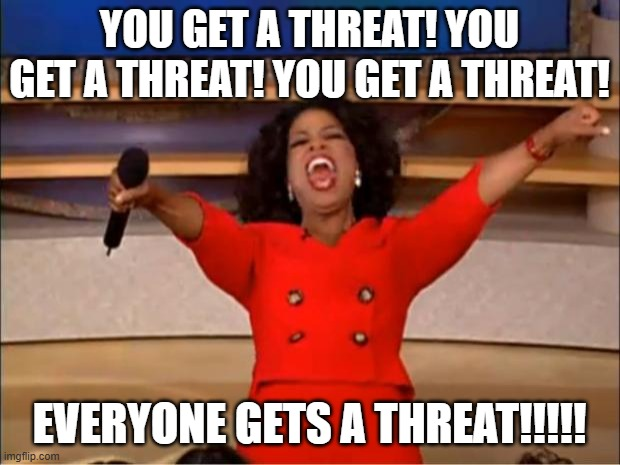Today the NZSIS (the Service) released its third Annual Threat Environment report. These reports are gold. It's one of the few documents where an NZ intelligence agency speaks openly about the threats we're facing, and names the countries those threats come from. The Service deserves applause for getting these reports started and for keeping them going.
I'm a big believer in threat-informed and threat-based security programmes, and when I finished my first read, what popped into my head was Oprah:

Insider threats are a problem. Foreign Interference can manifest as social pressure and co-opting of staff. We have to worry about foreign delegations, foreign business relationships and then on top of all those worries add in the fact that geo-strategic competition means more espionage, not less.
This report is not telling us we can take that nap we've all earned. It's a sobering reality check of the increasingly complex threat environment we are all trying to operate in. I'm going to keep my comments to the three threat areas within the report that are most relevant to us cyber security folk: foreign interference, insider threats and espionage.
Foreign Interference
Foreign interference activities continue in New Zealand with several states responsible. This includes activities regarded as transnational repression that often target diaspora communities. The People's Republic of China (PRC) gets a direct call out here, but the report points out the PRC is not the only state that engages in interference here in NZ. The key statements in the report about foreign interference that stood out to me are:
- Some foreign states have attempted to exploit people inside public and private sector organisations
- A case where a "co-optee" was advising influential decision makers (presumably politicians) was providing advice and guidance under direction from a foreign government
- Arrangements such as sister cities, and foreign delegations are often used to build long term relationships for influence and interference
- New Zealanders who are members of other nations' diaspora are under surveillance and scrutiny.
Do you, as a security team, think about how some of those you support could be targeted, or subject to higher threats? Many organisations work hard to get good baseline security everywhere. But do you have additional training, support or controls for highly attacked people? Are you thinking about your international partnerships with an interference lens? The threat is definitely here, and real.
Insider Threats
Insider threats from a wide range of areas are present in NZ.
What really struck me was that yes - the report talks about insider threats from motivated foreign nations seeking to exploit insiders and their knowledge - the issues-motivated insider threats are an issue too. The section on violent extremism states "No one ideology currently stands out as presenting a greater threat". As we've seen earlier this week, we've had our first ever conviction for espionage from, you guessed it - an insider threat who it appears was radicalised online and showed strong support for an issues-motivated group.
And after reading this year's report, managing insider threats is clearly something more organisations need to think about and build plans for.
Espionage
The report does a good job calling out espionage threats for critical infrastructure and government. For those of us keeping up with the Typhoons (Salt, Vault, Flax) and groups such as Cosy Bear and Lazarus Group that's probably not news. But the report contains this admission:
"It is almost certain there is undetected espionage activity that is harming New Zealand’s national interests."
Our intelligence community is not just worried about the espionage they can't see (of course they are), they're 90%+ confident there is espionage they are not seeing. That should be sobering, Threat actors operating in NZ currently unchecked is not great. We know that sophisticated threat actors are using Living off the Land techniques to get in, move around and maintain persistence without being detected. We need to be assuming breach, making sure that our organisations have good detection capabilities in place and planning (and doing) threat hunting.
What can you do?
The annual Threat Environment report is an excellent paper, and a great prompt to think about the threats you are facing as a cyber security professional.
From a cyber security and organisational security perspective, when I read that report I'm left with two major thoughts:
- Geo-politically, APAC is getting tougher, and more contested, not less. Global instability and strategic competition is raising the threat from foreign interference and espionage. New Zealand organisations need to make sure their protections are strong, they have good security strategies and programmes to help them keep improving.
- Organisations need to update their threat models: if you are in critical infrastructure, higher education or the public sector, you need to be updating your threat models, then flow this through so that your risks are mapping to your threats, and you can be confident your security controls are protecting you from the threats you are facing now.
We're Here to Help
If your organisation:
- Doesn’t have a threat model.
- Hasn't quite got its insider threat framework up and running.
- Deals with foreign delegations or partnerships but hasn't thought about PERSEC or national security risk before.
- Need help planning and/or doing a threat hunt.
- Is worried about whether your cyber security programme is keeping you safe from the threats you face.
Then Bastion is here to help you build a clear, resilient model for today’s risks.
With 150+ security nerds we have the expertise and capacity to help you with your security projects, hopes and dreams. Whether it's an insider threat review, building a threat model, doing a threat hunt for espionage actors or building a framework to managing 3rd party risks for foreign partnerships - we're here to help.


























